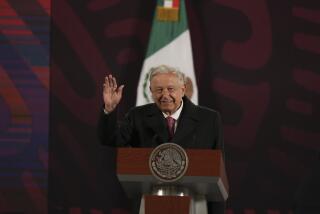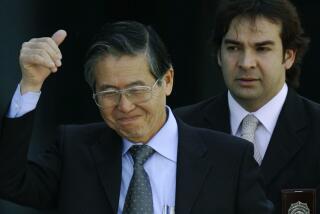Manuel Noriega, ousted Panamanian military dictator, dies at 83
Manuel Noriega, the Panamanian military dictator who often played opposing sides of Cold War-era political battles, until he was ousted by his on-again, off-again sponsors and toppled in a U.S. invasion, has died. He was 83.
A source close to Noriega’s family told the Associated Press that he died late Monday. There was no immediate information on the cause of death.
Noriega operated as a spy for the CIA, laundered money for Colombian drug traffickers, and worked in support of leftist movements in Latin America like Nicaragua’s Sandinistas — only to also help in U.S. efforts to fight them.
As head of the Panamanian armed forces, he also trampled on his nation’s attempts at a democratic process, positioning loyal candidates for the presidency and assuring their victories, regardless of the actual vote. And all the while, he amassed a fortune in mostly illicit funds.
Once overthrown by U.S. forces in 1989, Noriega spent an inordinate amount of time in jail, as dictators go. An American court in Miami convicted him on drug-running charges and put him in prison for nearly 20 years; then he was sent to trial in France and finally extradited home to Panama in December 2011 to face more jail time.
Noriega never had ideological compunctions and enjoyed goading the U.S., until his bravado led to his undoing. Ironically, he might have been relegated to history’s footnotes, as a minor Latin American caudillo, or strongman, had it not been for the U.S. invasion of Panama.
“Except for the fact that the U.S. invaded his country, put him on trial and put him in prison all those years, Noriega would not have been considered an important figure,” said John Dinges, a former journalist and author of “Our Man in Panama,” the 1990 account of Noriega, his misdeeds and U.S. ties.
“He was high on the corruption scale, mid-range on the human rights [abuse] scale, and on the left-right scale, in the middle,” Dinges, now a professor at Columbia University, said in a telephone interview. “That does not make him the worst in Latin America.”
Then-President George H.W. Bush was not quite a year into his administration when he grew weary of Noriega’s increasingly belligerent taunts, his failure to cooperate with former patrons like the Pentagon and the Central Intelligence Agency, and mounting evidence of his ties to the notorious Medellin Cartel of Colombia.
As many observers of the era have since concluded, U.S. officials made the decision to get rid of Noriega, and then sought a cause. That came with a couple of isolated attacks on U.S. military personnel stationed in Panama, including the killing of one serviceman and the assault on a Navy officer and his wife.
On Dec. 20, 1989, Operation Just Cause was launched, with more than 26,000 U.S. troops deployed to the tiny isthmus nation. Bush also asserted the need to “protect” the strategic Panama Canal. It was, at the time, the largest American military operation since the Vietnam War. And it was, as Dinges put it, “like using a mallet to swat a fly.” Former Mexican Foreign Minister Jorge Castañeda called it “the bloodiest, costliest and most disproportionate drug bust ever.”
The outgunned Panamanian Defense Force was quickly subdued. Noriega took refuge in the Vatican Embassy in Panama City, which U.S. troops bombarded — with loud rock music. Noriega, in his later memoirs, would refer to the din as “scorching diabolical noise.”
Within days, Noriega surrendered to the American military, which bundled him off to Miami. In all, 23 U.S. troops were killed in the invasion along with several hundred Panamanians, including many civilians who perished when their neighborhoods were destroyed and burned in the fighting.
Noriega would not set foot on Panamanian soil again, until his extradition from France on Dec. 11, 2011, when he was immediately placed in a prison called El Renacer (“Rebirth”).
In 2015, still a prisoner, Noriega apologized on Panamanian national television for the abuses and human rights violations committed during his regime. He asked for forgiveness for those he had hurt, affected or humiliated, saying he now wanted to “close the cycle of the military era.”
Manuel Antonio Noriega was born on Feb. 11, 1934, in a seedy bayside Panama City neighborhood. His mother worked as a maid; his father was a low-level civil servant. It is unlikely his parents were married to each other, and at 5 he was farmed out to proxies who raised him. That uncertain parentage, combined with his homely appearance (a lifelong battle with acne earned him a cratered complexion and the pejorative nickname of “Pineapple Face”), proved permanently traumatic for Noriega.
Though he showed promise in school, his poverty prevented him from pursuing the medical career he craved. Instead, he was educated in a military academy, and he joined the Panamanian National Guard upon graduation in 1962.
The young military officer became a protege of the legendary Panamanian nationalist Gen. Omar Torrijos and provided key ground support in the 1968 coup that overthrew a civilian government and established Torrijos as the country’s reigning strongman. Noriega rose to become head of military intelligence by the mid-1970s, making him the second most powerful person in the country and especially useful to U.S. spy agencies.
“From his earliest days, Noriega showed a penchant for manipulation and clandestine relationships that would later become the hallmarks of his personal life and his political career,” Frederick Kempe wrote in “Divorcing the Dictator” (1990).
“Too shy to take on the world directly, he cleverly used intelligence to outmaneuver friends and foes during his determined rise to power. Too ugly to charm, he still philandered and wooed, sometimes scoring through guile and other times through simple intimidation.”
Though it appeared not to stop his womanizing ways, Noriega married a shy schoolteacher, Felicidad Sieiro, in the 1960s. They would have three daughters.
In 1981, Torrijos was killed in a suspicious plane crash, and two years later, Noriega emerged from a series of power struggles as Panama’s de facto leader. He formed the Panamanian Defense Forces, consolidating the military and police into a single armed organization under his command.
Over the years, Noriega performed numerous tasks for the Americans, including serving as a secret back channel to Cuban leader Fidel Castro and allowing Panama to be used for training U.S.-backed Contras fighting Nicaragua’s Sandinista government, and U.S.-backed Salvadoran soldiers fighting that country’s leftist guerrillas. At the same time, he was supplying weapons from Cuba to the Sandinistas and the Salvadoran rebels. No task was performed without handsome fees.
The American administrations that benefited seemed willing to turn a blind eye to Noriega’s abuses at home. He is widely believed to have ordered the 1985 killing of Hugo Spadafora, an activist who denounced Noriega as a drug trafficker. Spadafora’s headless, tortured body was found stuffed into a U.S. mail bag near the Panama-Costa Rica border. Noriega also fixed elections and ordered presidents to resign when they dared to disobey him, including Nicolas Ardito Barletta in 1984 and Eric del Valle in 1988.
Crass and paranoid, with a voracious appetite for whiskey and women, Noriega seemed to relish many of the outlandish rumors that circulated around him, from a penchant for the occult to a hobby in bisexual exploits.
For all his brutality, Noriega was not without some domestic support. Like most Panamanians, he was dark-skinned, of mixed heritage, and he had come from humble roots. He used those characteristics in an attempt to exploit class warfare and rally many of Panama’s vast underclass against the wealthy white elite that disliked Noriega.
“For some of Panama’s poor, even the flawed Noriega stood as a nationalist symbol,” Saul Landau, a California-based scholar and filmmaker, wrote in The Times in 2001. “But bereft of the charisma or character to become a true national leader like Torrijos, … Noriega remained an almost caricatured intelligence officer, a shadowy dealer of information and services, even as he became head of state.”
Led by the white elite, and joined by many other ordinary Panamanians, an anti-Noriega protest movement gained traction in 1987. They would dress in white and stand on balconies and street corners, banging pots and pans. Noriega responded by suspending civil rights and unleashing shock troops called Dignity Battalions, a paramilitary force recruited from Panama’s poor and criminal gangs.
Washington stepped up its pressure to drive Noriega from power, suspending economic and military aid, indicting him on drug charges and backing a coup attempt that failed.
When presidential elections rolled around again in May 1989, Noriega’s candidate, by all accounts, was destined to lose to the opposition’s Guillermo Endara. Noriega annulled the elections as votes were being counted and then fought protesters in the streets. The blood-soaked white guayabera of the opposition’s vice presidential candidate, Guillermo Ford, made the front of U.S. newspapers and magazines, and quickly galvanized international opposition to Noriega.
There was little domestic U.S. opposition to the invasion that would come seven months after that election. But years later, in hindsight, many experts saw the Panama invasion as a low point in U.S. foreign policy. Although the stated goal of removing a dictator was accomplished, it came with a high cost in human lives, the use of substantial force, and with little follow-up.
Noriega, in his memoirs, 1997’s “America’s Prisoner,” denied he was working for the Colombian cartels and contended that he was ousted by Bush trying to compensate for his “wimp factor.”
In a 1994 jailhouse interview with filmmaker Oliver Stone, who was writing for the Nation, Noriega contended the Americans ousted him because he was no longer compliant.
“After 24 years of friendship suddenly I become a devil,” Noriega said. “They needed to create a devil in order to get rid of the devil. That’s what happened.”
As his health worsened in recent years, Noriega was shuttled from prison to local hospitals, where he was treated for a range of afflictions — bronchitis, hypertension, a possible stroke and finally a brain tumor. In January, the courts granted his request that he be allowed to return home — though remain under house arrest — while he was prepped for surgery.
ALSO
Jim Bunning, Hall of Fame pitcher and member of Congress, dies at 85
Gregg Allman dies at 69; Southern rock trailblazer co-founded band marked by tragedy
Award-winning sports journalist Frank Deford dies at 78
UPDATES:
11:15 p.m.: This article was updated to reflect that Noriega died late Monday.
This article was originally published at 10:25 p.m.
More to Read
Start your day right
Sign up for Essential California for the L.A. Times biggest news, features and recommendations in your inbox six days a week.
You may occasionally receive promotional content from the Los Angeles Times.







